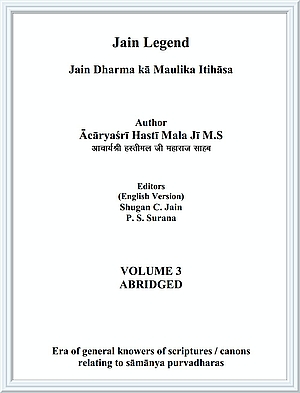- Siddha Sena Kṣamāśramaṇa: During the time of 30th epochalācārya Jina Bhadra Kṣamāśramaṇa, a distinguished influential ācārya by the name of Siddha Sena Kṣamāśramaṇa existed. He used to venerate Jina Bhadra Kṣamāśramaṇa like his teacher. He composed 'Jītakalpa cūrṇi' and 'Niśītha bhāṣya'. It can be inferred that he was a direct disciple of Jina Bhadra Kṣamāśramaṇa or a junior ācārya in his congregation.
- Koṭyācārya: A scholar ācārya by the name Koṭyācārya existed during the period of epochal-ācārya Jina Bhadra Kṣamāśramaṇa. As told earlier Jina Bhadra Kṣamāśramaṇa started composing the vṛatti of Viśeṣāvaśyakabhāṣya towards the end of his life and could complete only the six gaṇdhara doctrine before he died. Koṭyācārya completed that composition as 16000 verse long text. It is inferred that Koṭyācārya was a direct disciple of Jina Bhadra Kṣamāśramaṇa, was always busy serving his teacher and thus completed his incomplete composition in the end.
Other gaṇa and gaccha during the time of 30th epochal-ācārya
During his time, in V.N.1070 a new gaccha by the name Nāgendra came into existence. Like Koṭyācārya during that time another composer of holy texts, Siṃhamaṇi (Siṃhasūra), existed who wrote the ṭīkā on Naya Cakra.
Main composers of religious texts during the time of 29th and 30th pontiffs
- Koṭyācārya: He completed the incomplete self vṛtti of Viśeṣāvaśyakabhāṣya by Jina Bhadra Kṣamāśramaṇa. He also acquired deep knowledge of the literature composed by Jina Bhadra Kṣamāśramaṇa.
- Siṃhamaṇi (Siṃhasūra): He composed the philosophical work Naya Cakra ṭīkā.
- Koṭyācārya: He is a different scholar ācārya than Koṭyācārya. He wrote ṭīkā on Viśeṣāvaśyakabhāṣya. He existed during early part of Vikram 8th century.
Dynasties of the time of 29th and 30th pontiffs and 30th epochal-ācārya
During the period of epochal-ācārya Jina Bhadra Kṣamāśramaṇa, King Śīlāditya was the first ruler of Vallabhī. Viśeṣāvaśyakabhāṣya was composed by Jina Bhadra Kṣamāśramaṇa during his rule only.
Hūṇa dynasty
During the existence of Jina Bhadra Kṣamāśramaṇa, Hūṇarāja Mihirkula ruled over Mālawā and many parts of Rajasthan. Around V.N.1022, he ascended to the throne of Mālawā after the death of his father Mālawrāja Toramāṇa. He was a staunch enemy of Buddhists. He was a follower of Śaiva religion. Even being a foreigner, he adopted Hindu religion and became an ardent devotee of Lord Śiva. Mihirakula used to destroy Buddhist stupas and loot the Buddhists. During his reign, he inflicted many hardships on Buddhist bhikṣus. In about V.N.1059, Yaśodharmā scored a resounding victory over Mihirakula which is described in the victory pillar inscriptions of Mandsaura. However Yaśodharma neither killed nor imprisoned Mihirakula after the defeat but only made him serve him and left him as taxpaying ruler under his empire. Mihirakula died in V.N.106
 Acharya Hasti Mala
Acharya Hasti Mala
